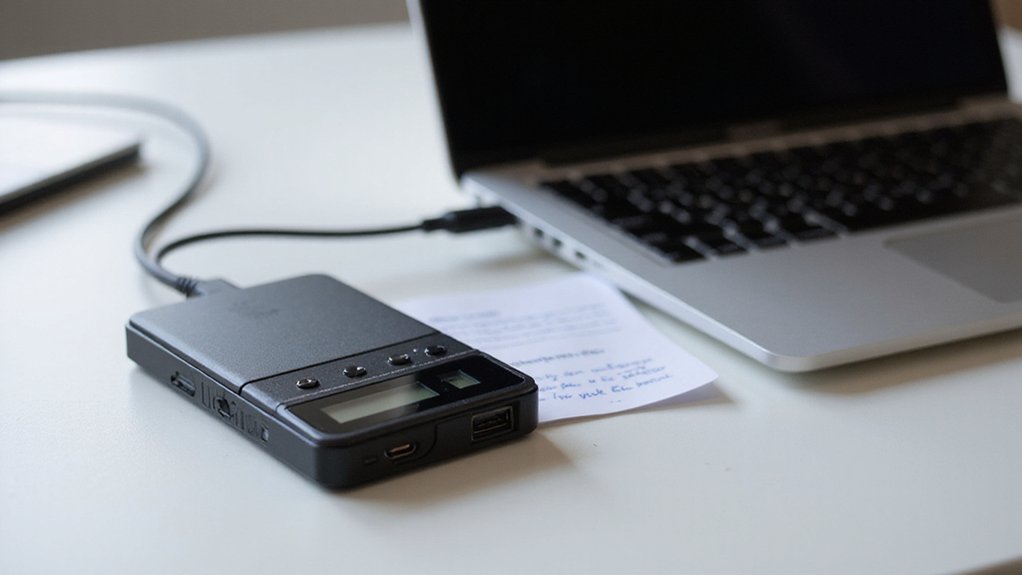A hardware wallet is a physical device that stores cryptocurrency private keys offline, offering a fortress-like defense against digital threats that software wallets simply cannot match. These specialized gadgets—resembling innocuous USB drives but housing sophisticated secure elements—execute transactions without exposing private keys to potentially compromised computers. For investors serious about security (and who isn’t, given crypto’s irreversible nature?), these devices represent the gold standard in asset protection. The difference between ownership and mere access becomes startlingly clear once examined.

A hardware wallet stands as the fortress in the often-vulnerable landscape of cryptocurrency security—a physical device engineered specifically to safeguard the private keys that grant access to one’s digital assets.
Safeguarding crypto’s vital keys within an impenetrable physical fortress, isolated from digital vulnerabilities.
Despite their USB drive-like appearance, these specialized devices serve a far more critical function: maintaining cryptocurrency private keys in an offline environment, effectively quarantining them from potential online threats.
Unlike exchanges or software wallets, hardware wallets never expose these cryptographic keys to internet-connected environments where malware might lurk.
The technical architecture of these devices centers around specialized secure chips—often the same tamper-resistant technology employed in high-security applications like banking cards.
When transactions require authorization, the signing occurs within this impenetrable environment, with the private key never leaving its secure enclave. These secure devices embody the principle of not your keys, not your crypto, emphasizing true ownership of digital assets.
This architecture renders even a compromised computer relatively harmless to one’s crypto holdings, as the keys remain physically segregated from vulnerable systems.
For cryptocurrency holders seeking transaction capabilities, hardware wallets connect to computers through proprietary software bridges that facilitate blockchain interactions without compromising security protocols.
Popular manufacturers like Ledger and Trezor have developed systems supporting a multitude of cryptocurrencies simultaneously, allowing diversified portfolio management from a single secure device. Many experts consider these devices part of cold storage solutions, the most secure method for protecting Bitcoin from internet-based threats.
While substantially more robust than their software counterparts, hardware wallets aren’t invulnerable.
Physical damage, theft, or improper backup procedures can still result in catastrophic asset loss.
The recovery mechanisms—typically seed phrases consisting of 12-24 random words—must be meticulously protected yet accessible in contingency scenarios.
The user experience balances security with practicality through minimalist interfaces—typically small screens with basic navigation buttons—that verify transaction details before authorization.
This verification step prevents the execution of manipulated transactions that might appear legitimate on a compromised display.
For serious cryptocurrency investors, the modest investment in a hardware wallet represents not merely an expense but rather an insurance policy against the not-insignificant possibility of digital asset expropriation in an ecosystem where transactions remain irreversible and recovery options nearly nonexistent. Though currently facing temporary access restrictions due to new UK regulations, providers like Ledger.com are actively working to restore full service to users in affected regions.
Frequently Asked Questions
How Much Do Hardware Wallets Typically Cost?
Hardware wallets typically range from $69 to $498, with distinct market tiers evident across the spectrum.
Budget-conscious investors might opt for the Trezor One at $69, while mid-range options from established brands like Ledger and Trezor populate the $100-$300 bracket.
Premium models such as the NGRAVE ZERO command nearly $500—a price point that, one might note, correlates with enhanced security features rather than mere aesthetic considerations (though sleek design rarely comes cheaply in this domain).
Can I Recover My Crypto if I Lose My Hardware Wallet?
Yes, cryptocurrency can be fully recovered if a hardware wallet is lost.
The recovery process hinges entirely on the recovery seed phrase—typically 12-24 words that serve as the cryptographic backup.
By purchasing a new compatible device and inputting this phrase during setup, all digital assets become accessible again.
This underscores why proper offline storage of recovery phrases (preferably in metal, not paper) remains the cardinal rule of crypto security—arguably more important than the physical device itself.
Are Hardware Wallets Compatible With All Cryptocurrencies?
Hardware wallets aren’t universally compatible with all cryptocurrencies.
While major assets like Bitcoin, Ethereum, and stablecoins enjoy broad support, compatibility varies considerably by manufacturer.
Ledger devices accommodate Bitcoin, Ethereum, XRP and numerous altcoins; Trezor prioritizes Bitcoin and “resilient” cryptocurrencies; SafePal claims support for 10,000+ assets.
Limitations stem from secure element constraints, blockchain-specific protocols, and companion app dependencies—making manufacturer claims about “thousands of supported tokens” somewhat aspirational rather than guaranteed.
How Often Should I Update My Hardware Wallet’s Firmware?
Hardware wallet firmware should be updated promptly when security patches are released, which typically occurs at irregular intervals (often 6-8+ months apart).
While manufacturers don’t follow fixed schedules, security-critical updates warrant immediate action regardless of timing.
Best practice includes verifying seed phrase backups beforehand, as updates occasionally require device resets.
For non-security enhancements—like new cryptocurrency support or interface improvements—users can adopt a more relaxed update cadence based on personal needs.
Can Hackers Remotely Access My Hardware Wallet?
Remote access to hardware wallets is greatly limited by their fundamental design—the private keys remain offline except during transactions.
However, vulnerabilities can emerge through compromised firmware updates, malicious bridge software, or supply chain attacks.
While theoretical attack vectors exist (particularly through software interfaces), properly maintained devices with regular firmware updates and cautious connection practices render remote exploitation exceedingly difficult.
A hardware wallet’s greatest vulnerabilities often stem from human error rather than sophisticated hacking techniques.









